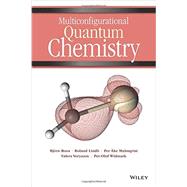
Multiconfigurational Quantum Chemistry
by Roos, Björn O.; Lindh, Roland; Malmqvist, Per Åke; Veryazov, Valera; Widmark, Per-Olof-

This Item Qualifies for Free Shipping!*
*Excludes marketplace orders.
Buy New
Rent Textbook
Rent Digital
Used Textbook
We're Sorry
Sold Out
How Marketplace Works:
- This item is offered by an independent seller and not shipped from our warehouse
- Item details like edition and cover design may differ from our description; see seller's comments before ordering.
- Sellers much confirm and ship within two business days; otherwise, the order will be cancelled and refunded.
- Marketplace purchases cannot be returned to eCampus.com. Contact the seller directly for inquiries; if no response within two days, contact customer service.
- Additional shipping costs apply to Marketplace purchases. Review shipping costs at checkout.
Summary
Author Biography
Table of Contents
Preface xi
Conventions and Units xiii
1 Introduction 1
1.1 References 4
2 Mathematical Background 7
2.1 Introduction 7
2.2 Convenient Matrix Algebra 7
2.3 Many-Electron Basis Functions 11
2.4 Probability Basics 14
2.5 Density Functions for Particles 16
2.6 Wave Functions and Density Functions 17
2.7 Density Matrices 18
2.8 References 22
3 Molecular Orbital Theory 23
3.1 Atomic Orbitals 24
3.1.1 The Hydrogen Atom 24
3.1.2 The Helium Atom 26
3.1.3 Many Electron Atoms 28
3.2 Molecular Orbitals 29
3.2.1 The Born–Oppenheimer Approximation 29
3.2.2 The LCAO Method 30
3.2.3 The Helium Dimer 34
3.2.4 The Lithium and Beryllium Dimers 35
3.2.5 The B to Ne Dimers 35
3.2.6 Heteronuclear Diatomic Molecules 37
3.2.7 Polyatomic Molecules 39
3.3 Further Reading 41
4 Hartree–Fock Theory 43
4.1 The Hartree–Fock Theory 44
4.1.1 Approximating the Wave Function 44
4.1.2 The Hartree–Fock Equations 45
4.2 Restrictions on The Hartree–Fock Wave Function 49
4.2.1 Spin Properties of Hartree–Fock Wave Functions 50
4.3 The Roothaan–Hall Equations 53
4.4 Practical Issues 55
4.4.1 Dissociation of Hydrogen Molecule 55
4.4.2 The Hartree-Fock Solution 56
4.5 Further Reading 57
4.6 References 58
5 Relativistic Effects 59
5.1 Relativistic Effects on Chemistry 59
5.2 Relativistic Quantum Chemistry 62
5.3 The Douglas–Kroll–Hess Transformation 64
5.4 Further Reading 66
5.5 References 66
6 Basis Sets 69
6.1 General Concepts 69
6.2 Slater Type Orbitals, STOs 70
6.3 Gaussian Type Orbitals, GTOs 71
6.3.1 Shell Structure Organization 71
6.3.2 Cartesian and Real Spherical Harmonics Angular Momentum Functions 72
6.4 Constructing Basis Sets 72
6.4.1 Obtaining Exponents 73
6.4.2 Contraction Schemes 73
6.4.3 Convergence in the Basis Set Size 77
6.5 Selection of Basis Sets 79
6.5.1 Effect of the Hamiltonian 79
6.5.2 Core Correlation 80
6.5.3 Other Issues 81
6.6 References 81
7 Second Quantization and Multiconfigurational Wave Functions 85
7.1 Second Quantization 85
7.2 Second Quantization Operators 86
7.3 Spin and Spin-Free Formalisms 89
7.4 Further Reading 90
7.5 References 91
8 Electron Correlation 93
8.1 Dynamical and Nondynamical Correlation 93
8.2 The Interelectron Cusp 94
8.3 Broken Bonds. (��)2→(��∗)2 97
8.4 Multiple Bonds, Aromatic Rings 99
8.5 Other Correlation Issues 100
8.6 Further Reading 102
8.7 References 102
9 Multiconfigurational SCF Theory 103
9.1 Multiconfigurational SCF Theory 103
9.1.1 The H2 Molecule 104
9.1.2 Multiple Bonds 107
9.1.3 Molecules with Competing Valence Structures 108
9.1.4 Transition States on Energy Surfaces 109
9.1.5 Other Cases of Near-Degeneracy Effects 110
9.1.6 Static and Dynamic Correlation 111
9.2 Determination of the MCSCF Wave Function 114
9.2.1 Exponential Operators and Orbital Transformations 115
9.2.2 Slater Determinants and Spin-Adapted State Functions 117
9.2.3 The MCSCF Gradient and Hessian 119
9.3 Complete and Restricted Active Spaces, the CASSCF and RASSCF Methods 121
9.3.1 State Average MCSCF 125
9.3.2 Novel MCSCF Methods 125
9.4 Choosing the Active Space 126
9.4.1 Atoms and Atomic Ions 126
9.4.2 Molecules Built from Main Group Atoms 128
9.5 References 130
10 The RAS State-Interaction Method 131
10.1 The Biorthogonal Transformation 131
10.2 Common One-Electron Properties 133
10.3 Wigner–Eckart Coefficients for Spin–Orbit Interaction 134
10.4 Unconventional Usage of RASSI 135
10.5 Further Reading 136
10.6 References 136
11 The Multireference CI Method 137
11.1 Single-Reference CI. Nonextensivity 137
11.2 Multireference CI 139
11.3 Further Reading 140
11.4 References 140
12 Multiconfigurational Reference Perturbation Theory 143
12.1 CASPT2 theory 143
12.1.1 Introduction 143
12.1.2 Quasi-Degenerate Rayleigh–Schrödinger Perturbation Theory 144
12.1.3 The First-Order Interacting Space 145
12.1.4 Multiconfigurational Root States 146
12.1.5 The CASPT2 Equations 148
12.1.6 IPEA, RASPT2, and MS-CASPT2 154
12.2 References 155
13 CASPT2/CASSCF Applications 157
13.1 Orbital Representations 158
13.1.1 Starting Orbitals: Atomic Orbitals 162
13.1.2 Starting Orbitals: Molecular Orbitals 164
13.2 Specific Applications 167
13.2.1 Ground State Reactions 167
13.2.2 Excited States–Vertical Excitation Energies 171
13.2.3 Photochemistry and Photophysics 184
13.2.4 Transition Metal Chemistry 194
13.2.5 Spin-Orbit Chemistry 202
13.2.6 Lanthanide Chemistry 207
13.2.7 Actinide Chemistry 209
13.2.8 RASSCF/RASPT2 Applications 212
13.3 References 216
Summary and Conclusion 219
Index 221
An electronic version of this book is available through VitalSource.
This book is viewable on PC, Mac, iPhone, iPad, iPod Touch, and most smartphones.
By purchasing, you will be able to view this book online, as well as download it, for the chosen number of days.
Digital License
You are licensing a digital product for a set duration. Durations are set forth in the product description, with "Lifetime" typically meaning five (5) years of online access and permanent download to a supported device. All licenses are non-transferable.
More details can be found here.
A downloadable version of this book is available through the eCampus Reader or compatible Adobe readers.
Applications are available on iOS, Android, PC, Mac, and Windows Mobile platforms.
Please view the compatibility matrix prior to purchase.
